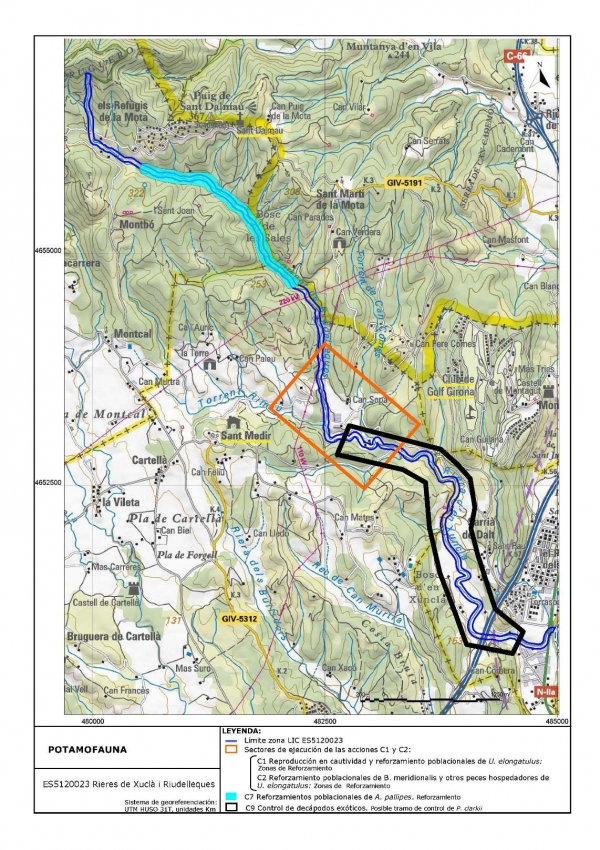Xuclà and Riudelleques streams
Surface: 51.300 hectares
The Natura 2000 area of Xuclà and Riudellques streams (ES5120023) is a river area with riparian forests in good condition, alder and mountain populations of barbel.
Xuclà and Rimau stream form a valuable a generally good condition ecosistem. As a community of riparian forest typical of Mediterranean environments there are alder forests with the habitat Lamia-Alnetum glutinosae. This is a lush and shade riparian forest, formed by a tree layer dominated by alder and poplar. It consists of common herbaceous species of Eurosiberian character forests as Nettle (Lamium flexuosum) or Lesser Celandine (Rannunculus ficaria). The fields that surround the river are also of great importance since it can create open spaces around the nearby forest.
The working area of the project does not include all of the SCI space, but a big part in this space is eminently river. Here the project area focuses only on streams and rivers, involving an area centered around these environments in which they live aquatic species objective of the project.
The importance of the populations of the streams of Xuclà and Riudelleques are mainly species objective of this project, essentially Unio elongatulus, Barbus meridionalis and Austropotamobius pallipes. Their presence is remarkable, although difficult to quantify in terms of demography.
the Naiad Unio elongatulus. Its regression in the basins of catalan rivers has been dramatic. The population of this species existing in Xuclà and Riudelleques streams is one of the few populations that are known by the middle stretch of the basin of the River Ter, along with Llémena and Brugent Rivers, and all the basins of North east of Catalonia. In Xuclà and Riudelleques Streams there is one locality with Unio elongatulus, located on a stretch of smooth channel. Within the river basin of the River Ter, one of the known populations with insufficient data on abundance, population structure, etc. Actions planned are stocking with captive-bred breeding laboratory naiads in Consorci de l’Estany from parental individuals of the same river basin.
Since there may be some genetic differentiation between basins and sub-basins, the units used must proceed within the same watershed in the Ter basin area. In each of these areas will choose between 2 and 4 sectors where reinforcements will be conducted with youth naiads and infestations of wild fish with naiads. These sectors will be allocated based on information previously available on the general state of the rivers in the area of general scope of the project and the current understanding of the requirements of the species and the status of their populations. Chosen stretches of river with a stable river channel morphology, suitable courses, good water quality, scarce natural hydrological stress, general good ecological status and the presence of at least one species of native fish host, among other criteria.
Mediterranean Barbel (Barbus meridionalis). This species is experiencing a gradual decline in the whole world as its distribution area is small, located in southern Europe. While still maintaining stable populations in dense areas or in some rivers, has disappeared from many sectors, especially along the main river areas that previously occupied. In the basin of Xuclà and Riudelleques streams, Barbus meridionalis is still maintaining stable populations but they are globally declining.
The recovery actions for Barbus meridionalis in the streams of Xuclà and Riudelleques depend on the relationship with stock recovery Unio elongatulus. In the places where the repopulatation with youth Unio elongatulus bred in captivity will be and aim, the the composition of fish will be studied, to ensure the presence of the guests for naiads as Barbus meridionalis or Squalius laietanus. In case of not having the presence of these species, repopulation will be done with Barbus meridionalis.
White-clawed Crayfish(Austropotamobius pallipes). The catalogue of threatened fauna species of Catalonia (pending approval) considered endangered (its short-term survival is unlikely). Wide distribution in Catalonia, but very localized mainly in small creeks and streams undisturbed. The situation of these species in Xulcà and Riudelleques Streams is delicate, but retains a single population. The populations of these species are located on small streams due to natural barrier (drought, cliffs ...) and the crayfish plague -the fungus. has not been reached. Currently populations suffer the threat of the spread of other crayfish.
The precise details about the process of reproduction in captivity of Austropotamobius pallipes is established in the corresponding protocol in accordance with the objectives of this project. One of the factors essential to incorporate this protocol is to maintain breeding lines for each separate area of origin of the parental units. The reinforcements population will be carried out in appropriate sectors of the SCI included in the performance area of the project. In some sectors where the species has disappeared, but always within the LIC which is still present, theses actions will enable the establishment of new populations are at least 1 in every SCI.

















